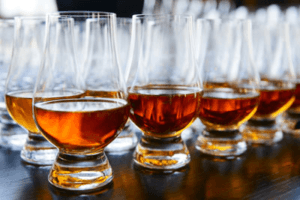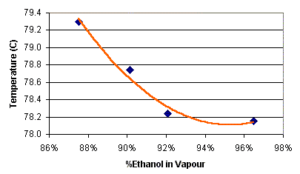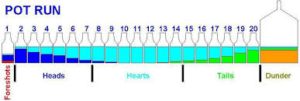A How To Guide To Cuts and Fractions – Pot Still Run
This guide will teach you about the different fractions that occur within a pot still distillation and how and when to make cuts thus allowing you to control the end flavor and quality of the spirit.
What are cuts ?
Cuts are predetermined points during a distillation run where a stiller will separates product coming from the still into separate containers. The end result is several different jars of product. Each having an individual flavor and abv.
How to know where to make cuts during distillation run ?
In order to determine where to make cuts when distilling you need to understand the different fractions of a run and learn how to recognize them during the distillation.
What are fractions?
Fractions are the individual components of a mixture of compounds that can be divided during phase transition. In our case fractions can be separated during the distillation process.
You can identify fractions using either still head temperature, by abv % or by taste this comes with experience. In any case once you learn how your still performs identifying fractions becomes predictable. Also keep in mind that during distillation still temperature rises and abv drops, they are directly related to each other and are an indication of what is coming out of your still.
Below is a list of compounds present in your wash and their specific boiling points. This gives you an idea at what temperature certain alcohols start to vaporize from the wash.
- Acetone 56.5C (134F)
- Methanol (wood alcohol) 64C (147F)

- Ethyl acetate 77.1C (171F)
- Ethanol 78C (172F)
- 2-Propanol (rubbing alcohol) 82C (180F)
- 1-Propanol 97C (207F)
- Water 100C (212F)
- Butanol 116C (241F)
- Amyl alcohol 137.8C (280F)
- Furfural 161C (322F)
When distilling with a pot still it is often desired to make several stripping runs before doing a final product run. This saves time and makes blending easier. If your interested in learning more about how to distill a stripping run check out Fundamentals of Distilling A Stripping Run.
What are the main Fractions that occur during the distillation of moonshine ?
There are four main fractions to be conceded with these include:
- Foreshots – The foreshots fraction is the first to be collected during the distillation process and contains a large percentage of acetone. Don’t even think about drinking this stuff. Generally during a pot still run we’ll allow for 150 ml per 25L of wash for our Foreshot Fraction. This get’s tossed down the drain. Foreshots can start coming from the still at 50 C.
- Heads – The Heads Fraction is a mixture of acetone, methanol, ethyl-acette and ethanol. You can expect the heads fraction to smell slightly sweet with a solvent like sting to it. It’s common practice to separate the heads and add them to the next distillation run as they contain a large amount of ethanol. General practice is to take 750 ml for Heads Fraction after Foreshots. You can take more or less personal perforce plays a big role in this decision.
- Hearts – The hearts fraction contains the highest percentage of ethanol and will have a very clean taste lacking the bite of the heads. It can be collected between 78-82°C or if you prefer abv between 80 -50 % with low wines of 40%. When blending fractions to make your final product the Hearts are the base of your product.
- Tails – The Tails fraction contains large amounts of fusel oils which cause unwanted flavors in your product. The tails can be identified by the distinctive smell of wet dog. Fusel oils aside there is a substantial amount of ethanol and rich flavors in the tails that are often desirable if you are making a rum or whiskey. These flavors can be extracted by doing a feints run. The feints run will yield a very flavorful product that can be used when blending the Hearts fraction. Collection of the tails can be ended when still temperatures reach 94 – 95°C or abv reaches 20% with low wines.

If your a newbie distiller and are just learning how to make cuts I’d recommended making the main cuts between heads to hearts, and hearts to tails. Get comfortable with this first before you move on to blending. If your comfortable with making these initial cuts then check out the Blending guide for Newbie’s. It will walk you through the process of blending whiskeys and rum for first timers.